Chinese
New Year celebrations officially ended with Chap Goh Meh, the 15th
day of the first lunar month but in Johor, the festive season does not end
until after the annual Johor Chingay, a religious celebration of the Johor Old
Temple.
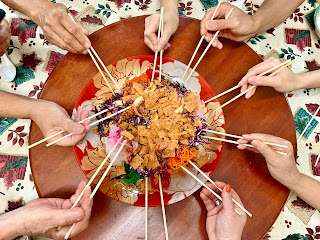 |
| Lo hei prosperity toss of Yee Sang at the start of our family reunion dinner 2022 |
Even
though the temple celebration and street parade proceeded under strict
conditions, the Chinese were pleased that this annual tradition was allowed to
go on.
Early
in the festive season, city malls were gaily decorated in auspicious Red for shoppers
to feel the festive vibe that was further enhanced by scheduled performances of
traditional high-pole lion dances and dramatic drum shows.
 |
| Traditional glutinous rice sweet cakes, kueh bakul or nian gao |
This
year, however, extra effort went into the decluttering of items accumulated
over the long lockdown periods. And after cleaning and dusting their homes,
traditional decorations in Red were put up again to usher in the new year.
About
a week before the dawn of the new year, traditional Chinese refreshed their
home altar and made an offering of nian gao (Mandarin), a glutinous rice
sweet cake or kueh bakul to the Kitchen god.
It
was believed that the Kitchen god would soon leave for heaven to make an annual
report on the family to the god of heaven.
 |
| My siblings and I with mum and cousin Bernice on Day One of Chinese New Year 2022 |
As
restrictions were lifted for inter-state travel, family members could travel
across the country – from North to South and East to West (and vise-versa!) –
to have their much-missed traditional family reunions.
Finally,
family members could meet for meals and have home visits and it was a joyous
occasion to be together again instead of just chatting through video calls.
 |
| Bernice with my mother and hers on a video call |
Once
again, we were blessed with festive gifts of home-made cookies and traditional
snacks like delicate love-letters folded into fans, presented in air-tight
metal tins (not plastic see-through jars with a red twist-on cover) just like
in the olden days.
Baked
pineapple tarts came in various forms – open tarts or covered ones, tubular or
artfully shaped like plump pineapples – for connoisseurs to savour and decide
which were their favourites in terms of the taste and texture of pastry and
jam.
 |
| Popular cake and cookies for Chinese New Year |
Meanwhile,
cousin Bernice made a special effort to come all the way from the UK and when
she had completed her home quarantine, she turned up in Johor Baru with her
parents to join us for our reunion dinner on the eve of Chinese New Year.
According
to Chinese traditions, daughters who were married would gather with their
husbands’ family in the home of their father-in-law or mother-in-law. After
all, they had changed their surnames and were counted as a member of that
family.
 |
| Traditional love-letter folded into a fan shape |
For
married daughters whose spouses were not Chinese or whose in-laws were
deceased, they could join the reunion dinner at her parents’ homes, if they so wished.
Our
family had a flexible arrangement for our reunion dinners and while dine-in was
allowed in restaurants, we still opted for takeaways or delivery of our
favourite festive food to enjoy the meals comfortably at home.
It
was indeed, meaningful to share this meal with elderly family members especially
when they were advancing in age and deteriorating in both health and strength.
 |
| Our takeaway Poon Choy, banquet in basin |
This elaborate dish is said to have originated in
Hong Kong during the late Song Dynasty (960 – 1279) when Mongol troops invaded
China and the young Emperors, brothers Zhao Shi and Zhao Bing, fled to the area
around Guangdong and Hong Kong.
The brothers and their imperial entourage were
welcomed by the local people and to feed them, they collected and cooked a
variety of their best ingredients.
 |
| Raising our glasses for a toast with refreshing pineapple juice. Cheers! |
In traditional village celebrations like religious
festivals, rituals and weddings, Poon Choy was served in metal wash basins
simmering over stoves, large enough to feed 10 to 12 persons.
A basin banquet may comprise between 9 to 18
courses of various ingredients that were separately cooked by stir-frying,
deep-frying, boiling, braising or stewing.
Now Chinese chefs may assemble each layer within a claypot
that included high-value and exotic ingredients like abalone, prawns, roast
meat, mushrooms, dried oysters, fish maw, dried seafood, goose feet and
vegetables.
After these ingredients were assembled in the basin,
they were further stewed for laborious hours to bring out exquisite flavours
that are fit for Emperors.
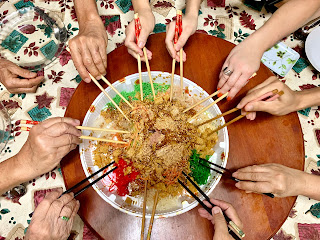 |
| Another prosperity toss of Yee Sang! |
Yee Sang was traditionally served on the Seventh
day of the first month in the new lunar year but due to its popularity, many restaurants
now served this dish throughout the festive season and was even available for
takeaways.
It was a dish designed for businessmen who wished
to toss the salad to great heights, a ritual adopted at the start of the new
year that was believed to augur well for greater prosperity and wealth in the
year ahead.
 |
| Nephew, Thomas Ng [Left] with Rafael Nadal [Right] |
As
none among us were involved in business, the well wishes uttered during our
salad toss were focused on the fulfilment of our desire for good health and
strength, success in careers, more grandchildren and for everyone’s wishes to
come true.
While
our reunion dinner was in progress, the television was on but instead of
Chinese New Year variety shows, it was on the Sports channel when the final
games of the Australian Open 2022 was being screened in a live-telecast from
Melbourne. So technically, Rafael Nadal also joined us for our reunion dinner.
Among
the greatest fans of Nadal were our aunts, Aunty Polly (with us in Johor Baru)
and Aunty Sylvia (then in Kuala Lumpur) who stayed in touch through WhatApp to
exchange comments as they thrilled to the final scores in this match.
At
Nadal’s winning stroke, the shouts of jubilation between these aunts plus those
from family members who follow the game, echoed through their telephones and I
was sure, around our neighbourhoods too.
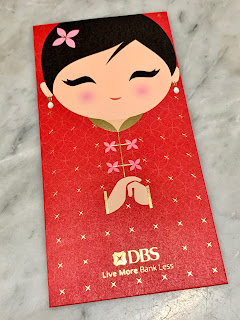 |
| The first Red packet I received this year, from cousin Richard and wife |
After
I bade farewell to our dinner guests and had sent them off, I was retuning indoors
when our neighbour - their son and daughter – greeted me with, Happy New
Year and kindly informed me that they would be setting off firecrackers at
midnight.
Even
though it was going to be just a brief burst of noise, they were concerned that
this fiery explosion may shock our aged mother – and our pet dog – so I thanked
them for their kind consideration to forewarn us.
Having
been forewarned, we remained calm when the explosions happened at the stroke of
midnight. This noise was echoed by other similar sounds from around the
neighbourhood but only for about half an hour at the dawn of the new lunar year.
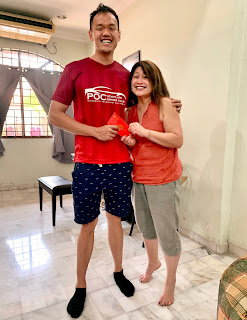 |
| Bernice presenting a traditional Red packet to nephew, Ivan |
Traditionally,
Red packets were presented by the elders to their children, whether married or
single, while single people were entitled to receive from all and sundry, mainly
from married relatives.
From
childhood, we were taught never to open Red packets when they were received but
to open them later at home. After all, it was never about the contents but all
about the well-wishes presented with those packets wrapped in auspicious Red.
Another
tradition about Red packets was how it was only given to those who came in
person to visit and greet the elders with well-wishes in the tradition of
filial piety.
 |
| My sister, Pearly, presenting Red packets to her grandchildren, hand-carried by Bernice to the UK |
The
global pandemic, however, had caused an adjustment to this tradition as the
elders decided to send their Red packets to those who could not travel nor
visit during the season, through relatives to present on their behalf.
[As
cousin Bernice would be returning to the UK, we could not only send our Red
packets through her but also gifts to our sister, Pearly and her family who
live there.
To
reduce the bulk of items for Bernice to pack on her return, I kept my gifts to
our grand-niece and grand-nephew, small enough to each fit into a large Red
packet.]
One
of my favourite festive foods during Chinese New Year must be a simple meal of
rice steamed with two types of Chinese sausages, stuffed with minced pork and
the other filled with duck liver, served hot and drizzled with a dollop of dark
soy sauce.
 |
| Steamed rice fragrant with Chinese sausages drizzled with dark soya sauce |
Grandfather’s
house in Johor Baru remains a precious memory especially as many members of the
extended family now live outside of Johor and abroad in the UK, Europe and
Australia.
Then
we learnt that Thomas, son of cousin Dennis whose family is based in Melbourne,
had met with Rafael Nadal in a restaurant while having lunch there, a few days
prior to Nadal’s massive win the night before.
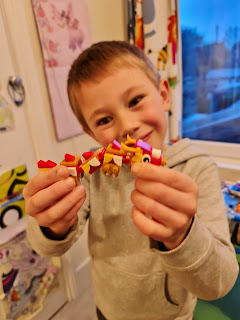 |
| My grand-nephew, Jamieson, with my gift of a dragon made of Lego |
On
Day Two of Chinese New Year, my brother and his wife hosted a family lunch in
their home with a few more guests, cousins Shirley and Felicia with their
families.
Our
small gathering was particularly joyous as it was a special reunion of family
members who had not met each other for just too long. It was so good for us in
JB to finally meet with relatives from Kota Kinabalu, Senai, USJ and the UK.
Meanwhile
in KL that very morning, Aunty Sylvia, who had their own family reunion the
previous night, was pleasantly surprised when her younger son, Ryan, decided
that they would take a drive to JB to visit us.
 |
| My grand-neice, Thea, with my gift of a panda made of Lego |
And
they turned at my brother’s house for a very pleasant surprise to all gathered
there. After dinner, they had another smooth drive back to KL that same night.
With
small group meet-ups for home visits, Chinese New Year celebrations this year
was indeed, very different from those of the past two years.
All
too soon the celebrations had passed and cousin Bernice had arrived safely back
in the UK to present our Red packets and gifts to my sister and her family.
As
the global pandemic continues to rage around the world and the virus is
mutating into dangerous variants, we are ever grateful for the blessings of
good health and strength, and the privilege to meet up again to make more
memories together.







No comments:
Post a Comment